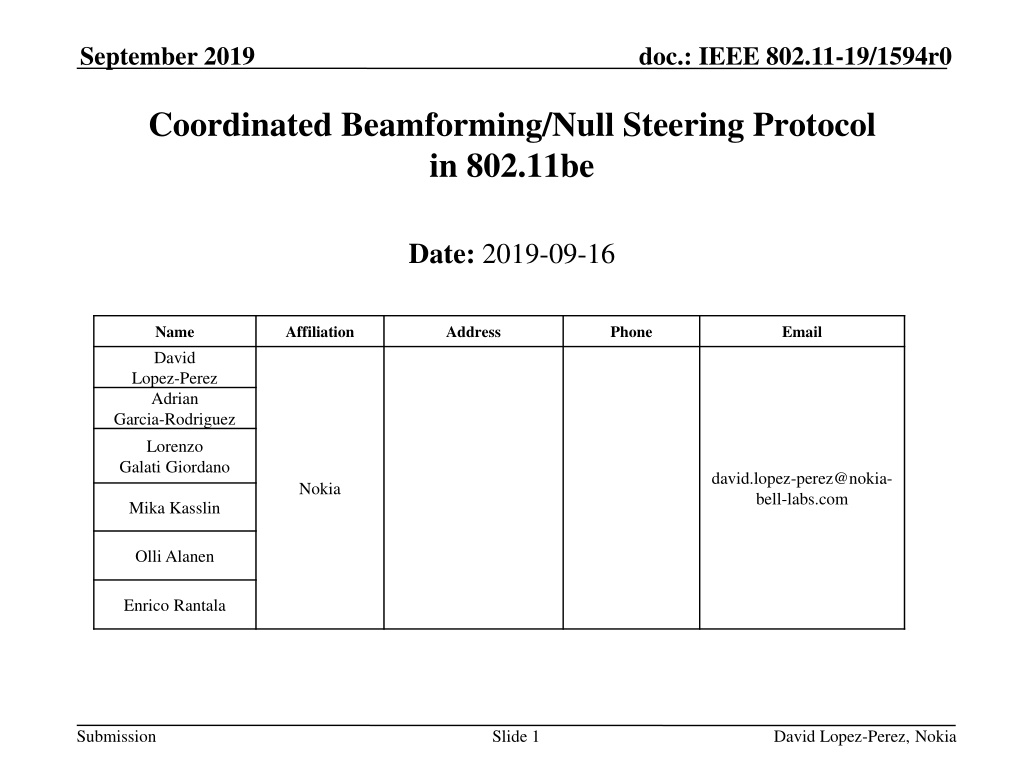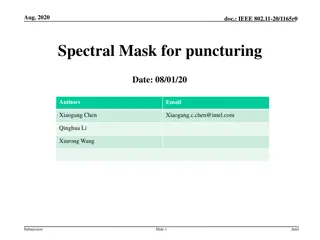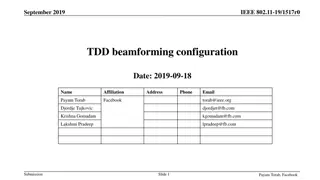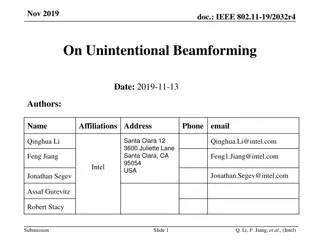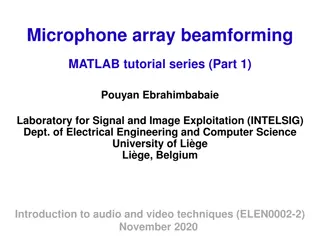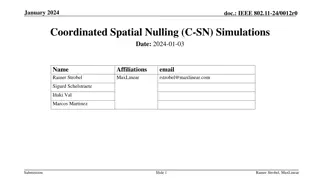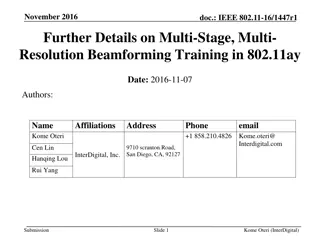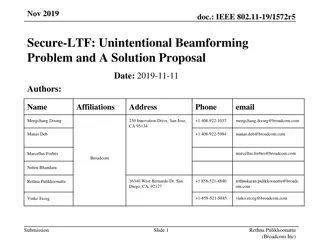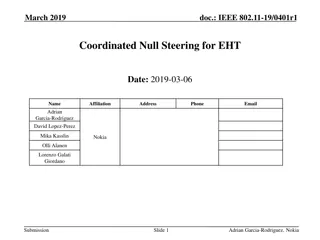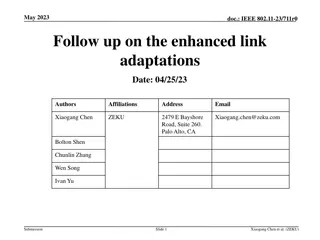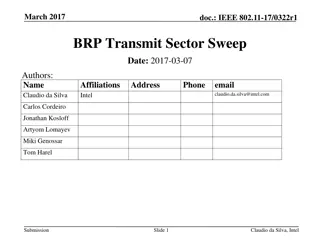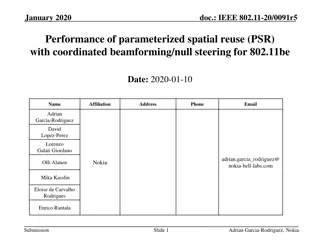Coordinated Beamforming/Null Steering Protocol in IEEE 802.11be
Coordinated beamforming/null steering is a promising scheme in IEEE 802.11be for joint transmission/reception challenges. This protocol aims to efficiently realize gains by establishing semi-static inter-AP coordination, enhancing spatial reuse opportunities, implementing CSI acquisition, and managing coordinated data transmission with nulls within TXOP.
Download Presentation

Please find below an Image/Link to download the presentation.
The content on the website is provided AS IS for your information and personal use only. It may not be sold, licensed, or shared on other websites without obtaining consent from the author. Download presentation by click this link. If you encounter any issues during the download, it is possible that the publisher has removed the file from their server.
E N D
Presentation Transcript
September 2019 doc.: IEEE 802.11-19/1594r0 Coordinated Beamforming/Null Steering Protocol in 802.11be Date: 2019-09-16 Authors: Name David Lopez-Perez Adrian Garcia-Rodriguez Lorenzo Galati Giordano Affiliation Address Phone Email david.lopez-perez@nokia- bell-labs.com Nokia Mika Kasslin Olli Alanen Enrico Rantala Submission Slide 1 David Lopez-Perez, Nokia
September 2019 doc.: IEEE 802.11-19/1594r0 Introduction Coordinated beamforming/null steering has attracted considerable attention in previous 802.11be meetings In this contribution, we review the major joint transmission/reception challenge, put forward coordinated beamforming/null steering, as an appealing inter- AP coordination scheme, and sketch a protocol to efficiently realize the coordinated beamforming/null steering gains Submission Slide 2 David Lopez-Perez, Nokia
September 2019 doc.: IEEE 802.11-19/1594r0 Coordinated beamforming/null steering as a first and handier step Joint transmission/reception provides theoretical gains over coordinated beamforming/null steering However, such gains may be hard to realise in practice Main concern: For retail and carrier markets, where backhaul is over-the- air, backhaul needs higher BW than fronthaul. 80MHz joint transmission fronthaul needs 160MHz backhaul [19/1089] Coordinated beamforming/null steering may offer a more appealing complexity/performance trade-off* Joint transmission/reception may be considered as An enterprise more complex 802.11be solution, and/or A post-802.11be future enhancement * A joint transmission/reception architecture can also realise coordinated beamforming/null steering Submission Slide 3 David Lopez-Perez, Nokia
September 2019 doc.: IEEE 802.11-19/1594r0 A protocol to realise coordinated beamforming/null steering An efficient protocol is needed to realise the coordinated beamforming/ null steering gains presented in earlier contributions Significant throughput gains of up to 2.7x (5%-tile) [19/1212] We are working on enhancing our simulation results in [19/1212] with the feedback obtained in previous meetings Such protocol requires: 0. Semi-static inter-AP coordination establishment 1. Enhanced spatial reuse opportunity (eSRO) coordination 2. CSI acquisition procedure 3. Coordinated inter-AP data transmission and acknowledgement with nulls Within TXOP Submission Slide 4 David Lopez-Perez, Nokia
September 2019 doc.: IEEE 802.11-19/1594r0 Reference scenario 2 APs with multiple antennas each more than STAs to serve 1 STA per AP with a single antenna and UL data to transmit (scheduled access) Simultaneous access due to inter-AP coordination and null steering STA11 UL data AP2 (donee) simultaneous access APs listen to each other AP1(donor) UL data STA21 Submission Slide 5 David Lopez-Perez, Nokia
September 2019 doc.: IEEE 802.11-19/1594r0 Phase 0 Semi-static inter-AP coordination establishment Similar to the inter-BSS set in 802.11ax, we propose the inter-BSS coordination set, which contains the IDs of all nodes that form part of the inter-BSS coordination set, is configured and updated on the fly in a semi-static manner, and is kept in the memory of each of those nodes Upon packet reception, a node will not discard packets from inter-BSS nodes that are included in its inter-BSS coordination set Related proposal at [19/1019] AP1 Inter-BSS coord_set_request AP2 Inter-BSS coord_set_response Example of message exchange to acquire the IDs of the AP and non-AP nodes to form an inter-BSS coordination set Submission Slide 6 David Lopez-Perez, Nokia
September 2019 doc.: IEEE 802.11-19/1594r0 Phase 1 Enhanced spatial reuse opportunity coordination Upon gaining a TXOP, an AP in the inter-BSS coordination set may proactively broadcast an enhancedspatial reuse opportunity (eSRO) with nulling capabilities This broadcast itself does not has nulls in place during its transmission APs willing to benefit from such eSRO shall respond, indicating the IDs of the nodes that would benefit from such interference mitigation Related proposal at [19/1143] donor AP1 spatialReuse_coordMsg donee AP2 spatialReuse_coordResponse My STA21 can benefit from nulling Example of message exchange to coordinate a spatial reuse opportunity with nulls and understand which nodes can take advantage of it Submission Slide 7 David Lopez-Perez, Nokia
September 2019 doc.: IEEE 802.11-19/1594r0 Phase 2 CSI acquisition procedure Once the donor AP decides which nodes to serve/null in the inter-AP coordinated transmission, APs participating in it require the relevant CSI to place the corresponding beams/nulls Thanks to the inter-BSS coordination set, any AP in the set can poke any other node in the set even if non-connected for such relevant CSI Explicit and implicit-CSI acquisition should be supported in 802.11be Through the NDPA, the donor AP reveals/indicates the nodes participating in the subsequent inter-AP coordinated transmission CSI acquisition may not be needed in all TXOPs Related proposals at [19/1097] and [19/1134] Submission Slide 8 David Lopez-Perez, Nokia
September 2019 doc.: IEEE 802.11-19/1594r0 Phase 2 Explicit CSI acquisition procedure TF NDPA NDP Feedback donor AP1 STA11 Feedback Feedback donee AP2 Feedback TF NDP STA 21 Feedback Feedback Transfer and return frames may be needed to coordinate AP1 and AP2 actions Through the NDPA, the donor AP reveals the nodes participating in the inter-AP coordinated transmission An AP can collect CSI from a neighbouring AP Submission Slide 9 David Lopez-Perez, Nokia
September 2019 doc.: IEEE 802.11-19/1594r0 Phase 2 Implicit CSI acquisition procedure TF NDPA NDP donor AP1 STA11 NDP NDP donee AP2 TF NDP STA 21 NDP NDP Transfer and return frames may be needed to coordinate AP1 and AP2 actions Through the NDPA, the donor AP reveals the nodes participating in the inter-AP coordinated transmission An AP can collect CSI from a neighbouring AP Submission Slide 10 David Lopez-Perez, Nokia
September 2019 doc.: IEEE 802.11-19/1594r0 Phase 3 Coordinated inter-AP DATA TX and ACK with nulls: An uplink-uplink example Similar to the spatial reuse parameter (SRP) framework in 802.11ax, The donor AP uses an enhanced TF to advertise the enhanced spatial reuse opportunity (eSRO) withnulling during its uplink reception The donee AP contends for the channel transmits a basic TF once its counter reaches zero its uplink reception and downlink acknowledgement must be within the TXOP of the donor node and sync with them Note that STAs of the slave AP could also content for the channel Null steering is used to make sure that inter-AP communications do not interfere each other (see next slide) Submission Slide 11 David Lopez-Perez, Nokia
September 2019 doc.: IEEE 802.11-19/1594r0 Phase 3 Coordinated inter-AP DATA TX and ACK with nulls: An uplink-uplink example eTF ACK donor AP1 STA11 UL data donee AP2 Thanks to the nulls, we can have concurrent ACKs Contention ACK TF STA 21 UL data STA11 UL data AP2 (donee) Note: Null3 is not required if contention- based access for STA 21 null3 simultaneous access APs listen to each other AP1(donor) UL data STA21 David Lopez-Perez, Nokia Submission Slide 12
September 2019 doc.: IEEE 802.11-19/1594r0 Conclusions In this contribution, building on 802.11ax, we have proposed an efficient coordinated beamforming/null steering protocol This protocol has four phases 0. Semi-static inter-AP coordination establishment 1. Enhanced spatial reuse opportunity (eSRO) coordination 2. CSI acquisition procedure 3. Coordinated inter-AP data transmission and acknowledgement with nulls The proposed protocol is inline with other 802.11be proposals Submission Slide 13 David Lopez-Perez, Nokia
September 2019 doc.: IEEE 802.11-19/1594r0 References Sammir Vermani (Qualcomm), Joint Transmissions: Backhaul and Gain State Issues, 19/1089 David Lope-Perez (Nokia), Performance of Coordinated Null Steering in 802.11be, 19/1212 Wook Bong Lee (Samsung), Virtual BSS For Multi AP Coordination, 19/1019 Sungjin Park (LG Electronics), Efficient Operation for Multi-AP Coordination, 19/1143 Ross Jian Yu (Huawei), Sounding procedure in AP collaboration, 19/1097 Kosuke Aio (Sony), Consideration on Multi-AP Sounding, 19/1134 Submission Slide 14 David Lopez-Perez, Nokia
September 2019 doc.: IEEE 802.11-19/1594r0 Straw Poll Do you believe coordinated beamforming/null steering is an appealing feature for 802.11be and that the 802.11be TG should look into it in more detail? Yes No Abstain Submission Slide 15 David Lopez-Perez, Nokia
